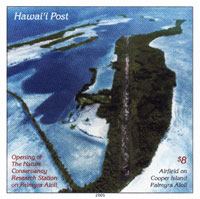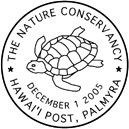Links.....
.
.
.
.
.
.
.
.
.
.
.
.
.
.
.
.
.
.
.
.
.
.
.
.
.
.
.
.
.
.
.
.
.
.
.
.
.
.
.
.
.
.
.
.
.
.
.
.
.
.
.
.
.
.
.
.
.
.
.
.
.
.
.
.
.
.
.
.
.
.
.
.
.
.
.
.
.
.
.
.
.
.
.
.
.
.
.
.
December 1st 2005 - Opening of The Nature Conservancy Research Station on Palmyra Atoll.
Three stamps and a mini-sheet were issued on December 1st 2005 to celebrate the Opening of The Nature Conservancy Reasearch Station on Palmyra Atoll.
Palmyra is an atoll situated about 1,000 miles southwest of Honolulu and about 350 miles north of the Equator. Palmyra consists of a circular string of about 50 islets nestled among several lagoons and encircled by about 15,000 acres of submerged reefs. It is the northernmost atoll in the Line Islands Archipelago. For almost a hundred years (1862-1959), Palmyra was legally part of Hawai'i. The climate is very hot and humid year round with an average of 175 inches of rain per year. It has a spectacular coral reef made up of some 130 species of coral. It's flora and fauna contain many unique specimens which occur nowhere else and are the subject of research being done at the new Research Facility, as well as climate change and other items of scientific interest.

The first European to sight the atoll was Captain Edmond Fanning on June 14th 1798, but he never landed. On November 7th 1802, Captain Sawle in his ship "Palmyra" was blown ashore there during a storm, hence the name of the atoll. In 1859, Dr. G.P. Judd in the American ship "Josephine" claimed possession of the atoll for the United States. However, in 1862 Captain Zenas Bent and Mr. Johnson B. Wilkinson, sailed to Palmyra from Honolulu and took possession of the atoll in the name of King Kamehameha IV of Hawai'i. When Hawai'i was annexed to the U.S. in 1898, Palmyra was in the treaty as part of Hawai'i. However, when Hawai'i became a state in 1959, Palmyra was specifically left out. Currently, Palmyra is an inincorporated territory of the U.S., administered by the U.S. Department of the Interior, but owned by The Nature Conservancy.
This is the chronology of private ownership:
1. April 15 1862 - Ownership established by Captain Zenas Bent and Johnson Wilkinson. Captain Bent later sells his interest to Wilkinson, whose wife then inherits the whole atoll.
2. 1885 - Upon the death of Mrs Wilkinson, her 3 heirs inherited it. 2 of the 3 heirs sell their interests to a Mr Wilcox who then transfers it to the Pacific Navigation Company. The third heir transfers his rights to a Mr. Ringer.
3. 1911 - Judge Henry Cooper of Honolulu buys the two-thirds share of the atoll from the Pacific Navigation Company.
4. 1912 - Mr. Ringer's children sell their rights to one third of Palmyra to Judge Cooper, who now owns the entire atoll.
5. August 19 1922 - The Fullard-Leo family of Hawai'i buys Palmyra from Judge Cooper for $15 million.
6. 1940-1946 - During World War II, the U.S. Navy takes over the atoll. At one time, their were six thousand sailors and marines stationed there. They dredged and created a seaplane runway by dynamiting and merging the two western lagoons into one. A north-south causeway was built between the two remaining lagoons. Using coral landfill, three of the northern islands in the atoll were merged into one and an airplane runway about one mile long was built, mostly on Cooper Island.
7. 1947 - The U.S. Government lays claim to the atoll, but is defeated in a Honolulu Court by the Fullard-Leo family who retain ownership.
8. May 4 2000 - After three years of negotiations, the Fullard-Leo family agrees to sell the atoll to The Nature Conservancy for an estimated $30 million. The Nature Conservancy is a nonprofit, tax-exempt corporation which was incorporated in 1951 in the District of Columbia for scientific and educational purposes. Land acquisition is a key protection tool used by the Nature Conservancy.
9. January 2001 - Designated a National Wildlife Refuge.
10. Fall 2005 - The Nature Conservancy opens it's new research facility on Palmyra after spending $1.5 million in improvements. 14 small cottages have been built which can sleep a staff of up to 28 people. Plus a separate kitchen and laboratory. A new septic system has been installed. Electricity is provided by a diesel generator. The Research Station on Palmyra will be staffed year-round by scientists from the "Palmyra Atoll Research Consortium" who come from:
. . . . . American Museum of Natural History
. . . . . California Academy of Sciences
. . . . . The Nature Conservancy
. . . . . Scripps Institute of Oceanography
. . . . . Stanford University
. . . . . University of California, Irvine
. . . . . University of California, Santa Barbara
. . . . . University of Hawai'i
. . . . . U.S. Geological Survey
. . . . . Victoria University of Wellington, New Zealand

Some intriguing stories about Palmyra:
In 1816, a Spanish pirate ship "The Esperanza" loaded with gold plundered from Incan temples was wrecked on Palmyra's reefs. The surviving crew allegedly buried the treasure on one of the small islets under some palm trees before leaving on three makeshift rafts. Two of the rafts were never seen again. The third raft was rescued by an American whaling ship. The sole survivor on the raft died soon after revealing the fate of his ship and the treasure. Since then, many have gone to Palmyra to search for the treasure, but nothing has ever been found. But the story of buried treasure on Palmyra remains.
In 1974, a married couple, Malcom "Mac" & Muff Graham, moored their yacht "Sea Wind" in the west lagoon of Palmyra. They went missing and were presumed to be lost at sea or dead. This true story was told in a book "And the Sea Will Tell" written by Vincent Bugliosi (author of Helter Skelter ) and published by Ballantine Books in 1991. It became a New York Times Bestseller and was made into a 2-part TV series of the same name in 1991. A man named Buck Walker who anchored his boat "Iola" at Palmyra at the same time the Grahams were there was later charged and convicted of the theft of the yacht and other crimes. Buck arrived back in Honolulu in the missing couple's yacht (he had changed the name to that of his old boat "Iola" which he had scuttled somewhere off Palmyra), but the boats were so different that it didn't fool anyone.
Six years later, the bones of Muff Graham were found in a box washed ashore on a Strawn Island beach by a visitor to Palmyra. There was a gaping hole in the forehead of her skull suggesting she was murdered. The remains of her husband Mac Graham were never found. Buck Walker was charged and convicted of the murder of Muff Graham. His girlfriend, Jennifer Jenkins, who accompanied Buck to Palmyra and back, was a vital witness at the sensational murder trial.
The $2 stamp (top image, above left) pays for extra charges, such as additional weight. It shows a map of Palmyra Atoll printed on blue-surfaced paper. The ocher-colored area shows the coral reef surrounding Palmyra which is partially exposed at low tide. The land area above the high tide mark is shown in green.
The $5 stamp (top image, above middle) prepays the Overnight rate. It shows the Coconut Crab (Birgus latro) which is prolific on Palmyra. The Coconut crab is the largest land crab in the world with adults reaching a leg span of up to three feet. During the day they hide in holes in the sand or under palm trees and shrubs. At night they forage along beaches and over coral rocks looking for food. They eat fruit, leaves and small animals. With their large front claws they can open and eat fallen coconuts.
The $8 stamp (top image, above right) prepays the Same Day rate. It shows a beach scene at Palmyra Atoll with coral rockheads poking through the sand.
The $8 mini-sheet (lower image, above) prepays the Same Day rate. It shows Palmyra Atoll from the air facing southwest and the overgrown runway of the airfield. The main lagoon and seaplane runway area can be seen from top right to middle left of the minisheet. The long man-made causeway that connects the northern part of the atoll to the southern islets is shown at the bottom left corner of the minisheet. The partially submerged coral reef that surrounds the atoll is clearly visible.
A Booklet consisting of 3 panes containing 2 x $2, 2 x $5 and 2 x $8 stamps was also issued. The booklet cover shows a view of one of the lagoons of Palmyra Atoll. Each pane consists of 2 stamps and has a white margin all around. "© 2005 Hawai'i Post" is printed vertically on the lower right side margin & Hawai'i Security Printers, Honolulu, Hawai'i. is printed on the bottom margin of each pane. The booklet cover is of white card stock and is stapled twice at the left side.

The postmark (above) for this issue shows a sea turtle which are commonly found swimming in the coral reefs of Palmyra.
Click here to order the stamps.
WE ACCEPT CREDIT CARDS ON ALL ORDERS
![]()
![]()
![]()
![]()
Technical details of the stamps and mini-sheet:
Colors: Multicolored.
Size: Stamps - 48mm x 32mm. Mini-sheet - 76mm x 70mm.
Stamp sheet size: 30. $2 & $8 (5 across, 6 down), $5 (6 across, 5 down).
Perforation: 12. Mini-sheet - imperforate.
Stamp design: Enelani.
Layout & Pre-press: Enelani.
Printer: Hawai'i Security Printers, Honolulu, Hawai'i.
Printing Method: 4-color (Cyan, Magenta, Yellow and Black).
Sheet margin markings: HAWAI'I POST (top middle), "Traffic Light" showing 5 colors used in printing (lower left side), © 2005 Hawai'i Post (lower right side) & Hawai'i Security Printers, Honolulu, Hawai'i. (bottom middle)
Paper: GPA coated white stock with water-activated gum on the back.
Return to list of stamp issues
For details on upcoming stamp issues click here